Audience analysis: What is it and how to do it?

Article summary
To sell successfully, you should understand who your target audience is, where they live, what they like, how to reach them. In this article, you will find a step-by-step guide to deep audience analysis with social listening tools.
Target audience analysis is the new consumer research. What used to take face-to-face interviews, consumer surveys, opinion polls, and focus groups is now a matter of choosing the right social listening tool that will take care of both research and analytics.
At this point, most (if not all) of your current and potential customers are on social media. And while social media monitoring is a key part of digital marketing technology, social listening is how you go beyond social media posts and directly to the users behind them. In other words, social listening is a shortcut to reliable consumer insights minus the hassle.
If you want more proof, I invite you to read up on the difference between social media monitoring and social listening. If you're convinced as is, I invite you on an audience analysis journey. Together, we'll explore the ways to use social listening for consumer research.
In case you feel like you might need a crash course or a quick recap of the many use cases of social media analytics, check out our guide on how to use a social listening tool.
What is audience analysis?
In simple terms, audience analysis is a full scan of your target markets in terms of:
- demographics
- locations
- languages
- attitudes
- interests
- beliefs
And so on. Audience to target that you research can be as broad or as narrow as you prefer, stretching from the location of your customer base to factors like political alliances and stances in public debates.
The one place where all of this information is publicly available is social media. It's essentially the world's largest database of consumer insights, with every age group represented in sufficient quantities. Target audience research relies on social data obtained via 24/7 monitoring of social media posts and the rest of the web, which means first-hand customer data.
The best part is how resource-undemanding yet effective target audience research with social listening is. The only tool that you'll need is an audience analysis tool of your choice, and that's it in terms of the budget. Once you've settled on a toolkit, audience analysis is underway as social media monitoring and listening are everything you'll need to get reliable results.
Why do audience analysis?
Audience analysis is the cornerstone of any business and marketing strategy. For new businesses, it's a brilliant way to gain a basic understanding of target audiences: geographic distribution, trends, preferences, interests — you name it.
When it comes to advertising campaigns planning and daily marketing activities of well-established brands, audience analytics provides an opportunity to answer very practical questions such as:
- What topics are popular with different target groups?
- What platforms bring the most audience engagement?
- Which of the competitors' campaigns work best across audiences?
- Which targeting criteria will secure maximum audience coverage?
Naturally, the list is not exhaustive and you discover more and more use cases of audience analysis as you go. Depending on the results of your initial audience analysis, you can decide how much further you need to go with researching a particular audience to target.
How to do audience analysis?
Unlike consumer research, traditionally done via face-to-face interviews, opinion polls, and focus groups, target audience analysis relies on social media data, publicly available and perfectly searchable.
The problem is, social media is huge, and nobody has sufficient time or capacity to be scanning social networks all day, every day. This is where social listening tools step in — your relentless helpers monitoring all of the Internet to find real conversations around the things important to your business.
For this audience analysis how-to, I'll be using Awario, but you're welcome to experiment and find a perfect software for your digital marketing needs.
By signing up I agree to the Terms of Use and Privacy Policy
Step 1. Set up mentions monitoring
Social listening starts with setting up mentions monitoring. Here, you need to decide on the keywords your social listening tool will be tracking. Your first choice is your brand name, then go product or advertising campaign names.
For purposes beyond target audience research (for example, if you want to generate leads on social media), it's also good to expand into branded analysis with your competitors and their basic product descriptions in focus.
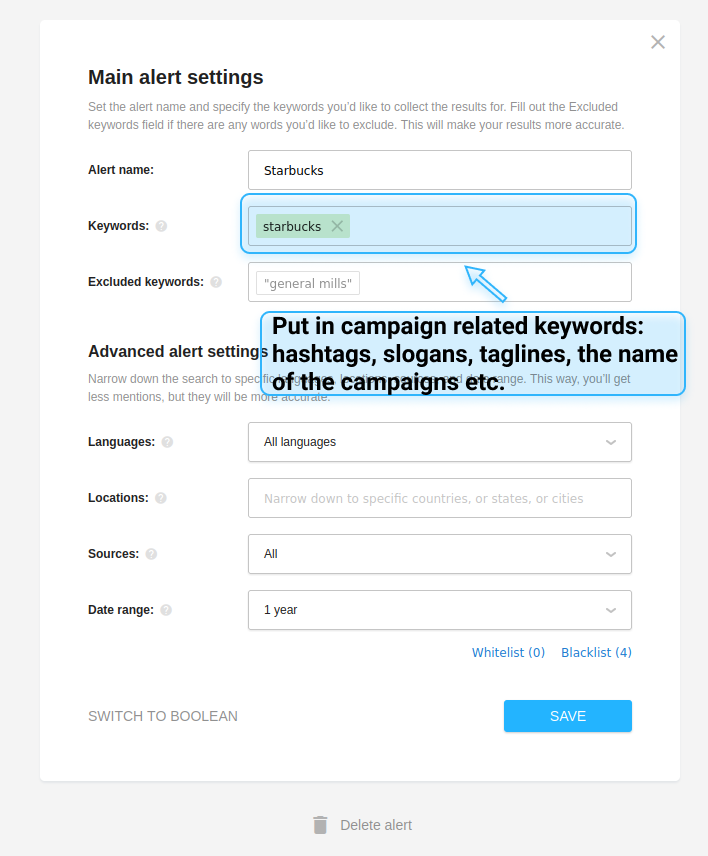
To access a wider audience through more general conversations around your product category or industry, you can create a separate mentions monitoring alert for niche-specific keywords like the name of your industry. This way, you'll expand audience analysis to the users not yet aware of your brand but already researching your product category.
Depending on how many brands, sources, locations, and languages you want to track (this can be adjusted in your alert settings), it takes anywhere from a couple of seconds to several hours to pick up every single post with your keywords found online.
Give your social listening tool some time to process enough data and go right for the audience analytics.
Step 2. Go to the Dashboard for audience analytics

The Dashboard is where all major social listening insights live. As a rule, the dashboard is interactive and flexible, which facilitates finding platform- or time-specific data. All of the analytics are in one way or another valuable for putting together traits your target customers share, as the data comes from real user conversations around your business and industry.
If you create alerts for competitor brands, when setting up conditions for brand monitoring, your social listening tool will track mentions of those as well, which can be of great use in learning more about audiences you share. In addition to that, when you have several brands in your social listening project, you're able to benchmark their analytics against each other.
On Dashboard, Awario analyzes up to three mentions at the same time.
Step 3. Take a closer look at your target audience
The Dashboard is populated with solid insights into brand perception, its reputation, and the amount of brand-related queries generated on social. Depending on the alerts you choose to examine, dashboard analytics will be different. You can view each alert separately to identify gaps or add multiple alerts to the same dashboard for brand-to-brand comparison.
While analytics like the volume of mentions and the sentiment behind them help you understand the conversations around your business and the type of feedback you receive, the rest of the insights are more audience-oriented.
Gender
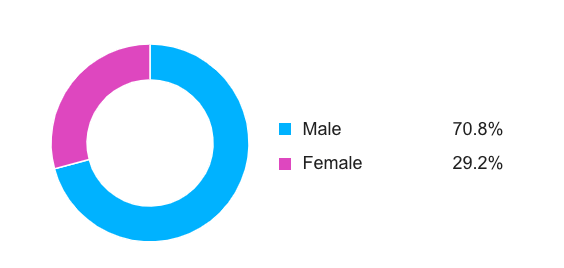
Targeting the audience by Gender through Awario's newest audience demographic analytics gives you an understanding of your customer demographics. With this knowledge, you can make more informed decisions on targeting, reach new audience groups, and even design better products.
Countries

Targeting the audience by geography, you can research Countries. By analyzing every post featuring your company found online, social listening tools map them across the world to highlight the locations where people talk about your brand.
When in addition to your brand you also track competitor's audience, you're able to see customer distribution in perspective.
If you're a global brand serving locations all over the world, make sure you include every variation of your brand name in different languages to get comprehensive monitoring results and a well-populated map.
Languages
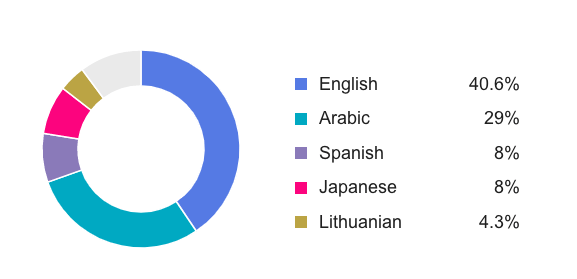
If you set up mentions monitoring in multiple languages, social listening tools give you a breakdown of the mentions' languages. Language insights, much like location insights, are valuable for understanding your audiences, improving targeting, and checking real demand for your products or services across different market segments.
Sources
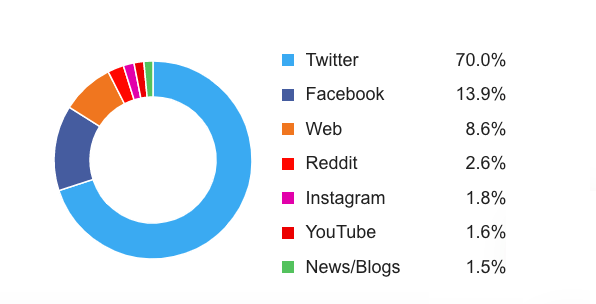
Sources are the platforms your brand mentions were found on. The more platforms you set your social listening tool to track, the more thorough the breakdown will be.
Sources are the social networks and web platforms your audience engages with most. These insights are needed to develop a coherent social media marketing technology and marketing strategy and gain an understanding of the coverage your brand receives.
Topic cloud
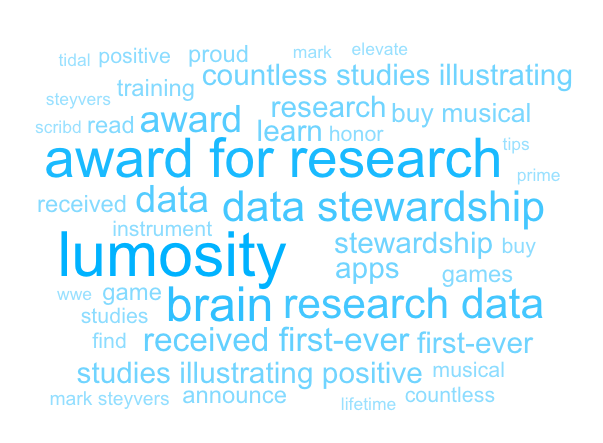
The topic or word cloud is real-time analytics of the words and phrases featured alongside your brand name most often. Topic cloud is brilliant if you want to discover trends, running themes, and questions your audiences bring up when talking about your company.
Make sure you keep an eye on the topics important to your customers as these reveal user concerns and help you understand the real attitudes towards your brand online.
Mentions and Influencers is a feed populated with the most important and popular mentions of your brand/competitors/products. It gives you a quick overview of niche influencers and opinion leaders who could be useful in managing campaigns and expanding your customer base.
To focus on specific audience members and discover more influencers, we'll move from the dashboard into the mentions feed.
Step 4. Connect with your audience's influencers
Social media influencers can be powerful allies in winning and retaining audiences. Whether you're after the personal connection that influencers strike or the brand authority they boost, make sure you use social listening to identify opinion leaders valued by your audiences.
There are many ways to find social media influencers using social listening tools, and the greatest thing about it is you get to identify very specific opinion leaders with different types of following and communication.
Start by going to the Mentions feed and sorting the posts by Reach — the total number of impressions they generated.

You're welcome to switch between different social media networks and time slots to discover influencers who'll work best with any particular target audience group. You can also take it one step further and apply a reach limit to pinpoint micro- or macro-influencers only.

The same process can be applied to your competitors' mentions feeds. By identifying and connecting with the influencers your competition works with, you can win powerful brand ambassadors whose message will resonate well with a similar target audience.
Most social listening tools let you interact with posts directly from the app. This means engaging with influencers as you go by replying, sharing, liking their content, or contacting them via DM's.

Step 5. Research and check user feedback
Now that we're working with raw user data, the time is perfect for fetching customer feedback on the products and services you or your competitors are offering. In any of your mentions feeds, run a search by a name of a product or a particular feature you want to analyze. Social listening tools let you check real user feedback, including from untagged brand mentions.
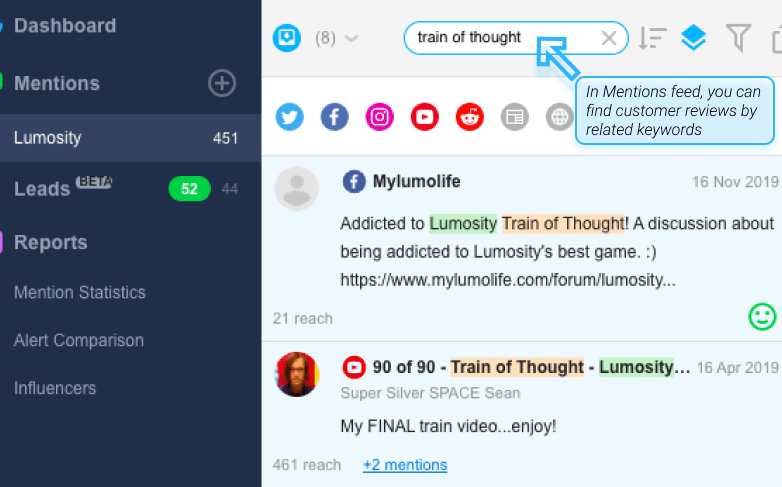
As soon as you've spotted any concerns or issues your audience likes to talk about, conduct a study! You read me right: social listening tools empower you to run research of any scale, studying your audience's attitudes towards anything from climate change to vaccination.
Fire up mentions monitoring using your research topic as a keyword and enjoy reliable findings with minimum involvement.
Wrapping up
Targeting the audience via social listening is the only sure-fire (and 100% respectful of any privacy policy) way into your customers' minds and hearts. Social listening tools reduce the process of researching your customer base to setting up continuous social media monitoring and keeping an eye on the analytics. Make sure you give target audience analysis a go with a social listening tool of your choice and experience consumer research on a new level.













